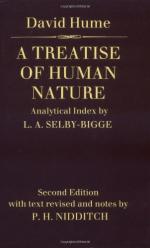
|
| Name: _________________________ | Period: ___________________ |
This test consists of 15 multiple choice questions and 5 short answer questions.
Multiple Choice Questions
1. On what does Hume consider moral distinctions are based in this section?
(a) Morality or immorality.
(b) Nature or nurture.
(c) Love or hate.
(d) Justice or injustice.
2. What virtue allows humans to be governed?
(a) Honesty.
(b) Sympathy.
(c) Politeness.
(d) Loyalty.
3. Which of the following is a natural ability?
(a) Laughter.
(b) Humor.
(c) Sleep.
(d) Industry.
4. Why do individuals want to fake the practice of virtue?
(a) They want to fit into society.
(b) They want to make friends.
(c) They want to be accepted by God.
(d) The want moral approval.
5. What does Hume say happens to justice over time?
(a) It gets more complex.
(b) It is needed less and less.
(c) It gets less just.
(d) It gets simpler.
6. What is Hume's argument against religion's view on free will?
(a) One can't understand oneself with free will.
(b) One can't find happiness with free will.
(c) One can't be moral with free will.
(d) One can't be a solid member of society with free will.
7. Hume says religious people focus on what?
(a) Judgement.
(b) Virtues.
(c) Love and hate.
(d) Free will.
8. What passion does Hume say pity is like?
(a) Hate.
(b) Love.
(c) Sympathy.
(d) Envy.
9. What direct passions do natural instincts produce?
(a) Love and hate.
(b) Fear and hate.
(c) Desire and joy.
(d) Pleasure and pain.
10. By what does Hume say all human action is determined?
(a) Perception.
(b) Morals.
(c) Love.
(d) Impressions.
11. What does religion argue about free will?
(a) One can't believe in God without free will.
(b) One can't go to heaven without free will.
(c) One can't fall in love without free will.
(d) One can't be moral without free will.
12. What is the title of Book Two, Part Three?
(a) Of the Will and Direct Passions.
(b) Of Justice and Morality.
(c) Of Love and Hate.
(d) Of Free Will and Indirect Passion.
13. What does Hume say none of his three motives of human nature are sufficient enough to produce?
(a) Morals.
(b) Disorder.
(c) Order.
(d) Justice.
14. Of what does Hume say we have a false sensation?
(a) Underlying emotion.
(b) Caused choice.
(c) Sub-emotion.
(d) Uncaused choice.
15. What kind of point of view does sympathy allow us to take?
(a) An individual point of view.
(b) A subjective point of view.
(c) A personable point of view.
(d) A general point of view.
Short Answer Questions
1. What do moral judgments intrinsically motivate?
2. What does Hume think a proper understanding of the will help us to understand?
3. Which virtues does Hume say are instinctual?
4. What can one not derive an ought from?
5. Which of the following does Hume suggest is the true origin of morals?
|
This section contains 427 words (approx. 2 pages at 300 words per page) |

|




